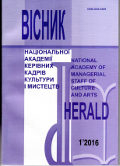LVIV ART HISTORY IN THE PERIOD OF SOVIET TOTALITARISM
DOI:
https://doi.org/10.32461/2226-3209.1.2016.138495Keywords:
arts science, totalitarianism, institution, museum, thesis, conferenceAbstract
Arts is a branch of the humanities that considers art in wide public, social and cultural aspects. To understandthe current state of arts science, we need to call to its history, namely the development of this science in one of the largestcenters of our country – the city of Lviv, and name the first scientists in the field. Resolving this issue will provide theunderstanding of the integrity of Ukrainian art. In Soviet times, arts science focused mainly in Moscow and Leningrad(now – St. Petersburg) – namely, the Moscow Lomonosov State University and the Leningrad Repin Institute of Painting,Sculpture and Architecture. All scientific councils on arts thesis defense concentrated mainly in these cities. One of theimportant centers of arts science is Ukrainian City of Lviv. Thus, its first researchers in 1970 were candidates of Art: Antin
Budzan, PavloZholtovsky, YakymZapasko, YuriyLashchuk, VolodymyrOvsiychuk, ViraSventsitska. The main centers,where the first art museums of the city are concentrated – the Lviv Museum of Ukrainian Art, the Lviv Art Gallery, theMuseum of Ethnography and Crafts, the Lviv History Museum; and educational institutions of the city – the Lviv StateInstitute of Crafts and Decorative Arts and the Ukrainian Ivan Fedorov Polygraphic Institute. Thus, several researchers ofUkrainian art have worked in the Lviv Museum of Ukrainian Art (now – the Andrew Sheptytsky National Museum). Themost famous of them – Vira Sventsitska (most significant work – "Heritage of ages. Ukrainian painting of XIV – XVII centuries"),Irina Gurgula ("Folk Art of Western Ukraine"), Sofia Czechowicz ("Folk masters" (co-author).) JaroslavNanovskiy ("Ivan Trush", "Julian Pankevych"), Mykola Batih, Vitaliy Ostrovskiy ("Ivan Trush", "Anton Monastyrskiy", "Anton Mikhailovich Kashshay", "Artist of the Soviet Transcarpathian region"). Another significant center where local art researchersconcentrated was the Lviv Art Gallery. The eminent Ukrainian art researchers worked here – Borys Voznytsky(author of works "Olesky castle", "Boim Chapel in Lviv"), Olena Ripko ("Searching for executed past: a retrospective ofartistic culture of the city of the twentieth century"), Gregory Ostrovskyy ("Artists of the Soviet Transcarpathian region","Lviv", "Lviv Art museums", "Zachariy Zograf", "Roman Selskiy"), Anatoliy Popov ("Elena Kulchytskaya: Graphics, Art").
The Museum of Ethnography and Crafts is one of the most important centers of Lviv arts science. Well-educated art researcherPavlo Zholtovsky worked here ("Ukrainian painting of XVII – XVIII centuries", "Dictionary Encyclopedia of artistswho worked in Ukraine in XVI – XVIII centuries", "Artistic life in Ukraine in XVI – XVIII centuries"), Yuriy Lashchuk ("Kosivceramics", "Ukrainian potters", "Development of Ukrainian national art crafts"), Faina Petriakova ("Modern Ukrainian artglass", "Ukrainian art porcelain (end of XVI – beg. of XX century.)"), Mykola Mozdyr ("Ukrainian folk memorial sculpture","Ukrainian folk wooden sculpture", "Lupiychuk – spirit of Ukrainian Cossacks"), Ivan Seniv ("Works of Olena Kulchytska","Essays on the history of Ukrainian arts and crafts"). Antin Budzan worked on Ukrainian decorative carving and VladimirRozhankivskiy worked on Crafts Blown Glass in the Lviv Museum of Ukrainian Art, and later – in the Museum of Ethnographyand Crafts.
The fourth center of Lviv arts science was the Lviv Historical Museum, where its director is Gregory Yakushchenkoworked. The outstanding Ukrainian art critic Yakim Zapasko, who was the expert on the history of old booksand publishing in Ukraine worked in the Lviv State Institute of Crafts and Decorative Art (now – the Lviv National Academyof Arts). The Ukrainian researcher of graphics and typography Hrystyna Sanotska worked in the Ukrainian Ivan Fedorovpolygraphic institute (now – the Ukrainian Academy of Printing). Indisputable is the fact that all Ukrainian scientistshad desire to participate in conferences that were held in Moscow and Leningrad. As an example, we have a conferencewith the Institute of Ethnology Archives in Lviv. In Lviv, they were mostly local and usually have been devoted to the lifeand work of individual artists, as well as to the anniversary of the museum, scientific or educational institutions. As anexample, we can name conferences on works of Olena Kulchytska, Ivan Trush, Vasyl Kasian, Mykola Martinovich, LeopoldLevitskiy, Oleksa Nowakowski. Thus, the Ukrainian arts science during Soviet totalitarianism was marked with inferiorityin comparison to Russian. At this time the main development centers of Art in Lviv were museums and universities.
This period is the emergence of new researchers in the national arts science, who in 1970 already had a scientific degreeof "candidate of art" and worked mostly in museums and universities. Researchers have written and published a ьnumber of powerful works on the history of Ukrainian art, although, considering the time, not without signs of Soviet bias. Intheir works, scientists and artists turned to Ukrainian folk culture. They saw a strong foundation and guarantee of nationalidentity in it. At this time, a new scientific field that studied Ukrainian art appeared, as well as the main stages of its development,character and relationships with other cultures, thus ensuring the growth of Ukrainian national consciousness.
Downloads
Published
Issue
Section
License
Authors who publish with this journal agree to the following terms:
1. Authors retain copyright and grant the journal right of first publication with the work simultaneously licensed under a Creative Commons Attribution License International CC-BY that allows others to share the work with an acknowledgement of the work's authorship and initial publication in this journal.
2. Authors are able to enter into separate, additional contractual arrangements for the non-exclusive distribution of the journal's published version of the work (e.g., post it to an institutional repository or publish it in a book), with an acknowledgement of its initial publication in this journal.
3. Authors are permitted and encouraged to post their work online (e.g., in institutional repositories or on their website) prior to and during the submission process, as it can lead to productive exchanges, as well as earlier and greater citation of published work (See The Effect of Open Access).


